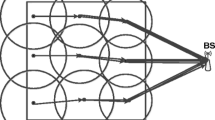Abstract
In this paper, a Modified Adaptive Cluster-Based Heuristic Approach (MACHBA) has been proposed for wireless sensor networks (WSNs) to perform the cooperative spectrum sensing (CSS) in the shopping mall, weather forecasting, military area and audio, video transmission applications. A Secure CSS based MACBHA has been proposed for secondary spectrum usage. Unlicensed Secondary Users (SUs) utilize parts of the spectrum, which are not used by the licensed primary users (PUs) in cognitive radio WSNs. The unused spectrum of the PUs is utilized by the secondary user cluster. The performance of the MACBHA in WSNs is evaluated using the network simulator tool NS-2.35 in Ubuntu 16.04.6 LTS (Xenial Xerus) operating system. The simulation result shows the performance improvement in network utility. Even though, the number of SUs increases, a minimum latency is achieved.













Similar content being viewed by others
References
Ganti, R. K., Ye, F., & Lei, H. (2011). Mobile crowd sensing: Current state and future challenges. IEEE Communications Magazine, 49(11), 32–39.
Hachem, S., Pathak, A., & Issarny, V. (2013). Probabilistic registration for large-scale mobile participatory sensing. In 2013 IEEE international conference on pervasive computing and communications (PerCom). IEEE.
Philipp, D., et al. (2013). Drops: Model-driven optimization for public sensing systems. In 2013 IEEE international conference on pervasive computing and communications (PerCom). IEEE.
Shafiee, M., & Vakili, V. T. (2017). United versus cooperative spectrum sensing in cognitive wireless sensor networks (C-WSNs). Wireless Personal Communications, 95, 2461–2483.
Ferrari, F., et al. (2012). Low-power wireless bus. In Proceedings of the 10th ACM conference on embedded network sensor systems. ACM.
Reddy, S., Estrin, D., & Srivastava, M. (2010). Recruitment framework for participatory sensing data collections. In International conference on pervasive computing. Berlin: Springer.
Ahmed, A., et al. (2011) Distance and time based node selection for probabilistic coverage in people-centric sensing. In 2011 8th annual IEEE communications society conference on sensor, mesh and ad hoc communications and networks. IEEE.
Weinberg, J., Brown, L. D., & Stroud, J. R. (2007). Bayesian forecasting of an inhomogeneous Poisson process with applications to call center data. Journal of the American Statistical Association, 102(480), 1185–1198.
Cohn, G., et al. (2012). An ultra-low-power human body motion sensor using static electric field sensing. In Proceedings of the 2012 ACM conference on ubiquitous computing. ACM.
Li, S. Z., et al. (2002). Statistical learning of multi-view face detection. In European conference on computer vision. Berlin: Springer.
Lane, N. D., et al. (2013) Piggyback crowd sensing (PCS): Energy efficient crowd sourcing of mobile sensor data by exploiting smartphone app opportunities. In Proceedings of the 11th ACM conference on embedded networked sensor systems. ACM.
Liu, T., et al. (2014) Methods for sensing urban noises. In Technical reports on MSR-TR-2014-66.
Roy, N., et al. (2011). An energy-efficient quality adaptive framework for multi-modal sensor context recognition. In 2011 IEEE international conference on pervasive computing and communications (PerCom). IEEE.
Gordon, D., et al. (2012). Energy-efficient activity recognition using prediction. In 2012 16th international symposium on wearable computers. IEEE.
Wang, Y., et al. (2009). A framework of energy efficient mobile sensing for automatic user state recognition. In Proceedings of the 7th international conference on mobile systems, applications, and services. ACM.
Priyantha, B., Lymberopoulos, D., & Liu, J. (2011). Littlerock: Enabling energy-efficient continuous sensing on mobile phones. IEEE Pervasive Computing, 10(2), 12–15.
Chen, Y. (2008). Optimum number of secondary users in collaborative spectrum sensing considering resources usage efficiency. IEEE Communications Letters, 12(12), 877–879.
Sharma, G., & Sharma, R. (2018). Optimised fusion rule in cluster-based energy-efficient CSS for cognitive radio networks. International Journal of Electronics, 106, 741–755.
Sudhakaran, C., & Suganthi, M. (2019). Distributed algorithm to reduce contention in emergency situations by deploying cognitive radio ad-hoc controllers. IET Communications, 13(17), 2814–2819.
Sudhakaran, C., & Suganthi, M. (2018). A novel approach of user existence awareness using adaptive spectrum sensing controllers in emergency-based cognitive radio ad hoc networks. International Journal of Communication Systems, 31, e3705.
Lee, D.-J. (2014). Adaptive random access for cooperative spectrum sensing in cognitive radio networks. IEEE Transactions on Wireless Communications, 14(2), 831–840.
Author information
Authors and Affiliations
Corresponding author
Additional information
Publisher's Note
Springer Nature remains neutral with regard to jurisdictional claims in published maps and institutional affiliations.
Rights and permissions
About this article
Cite this article
Devaraj, S.A., Aruna, T. MACBHA: Modified Adaptive Cluster-Based Heuristic Approach with Co-operative Spectrum Sensing in Wireless Sensor Networks. Wireless Pers Commun 114, 69–84 (2020). https://doi.org/10.1007/s11277-020-07350-x
Published:
Issue Date:
DOI: https://doi.org/10.1007/s11277-020-07350-x




